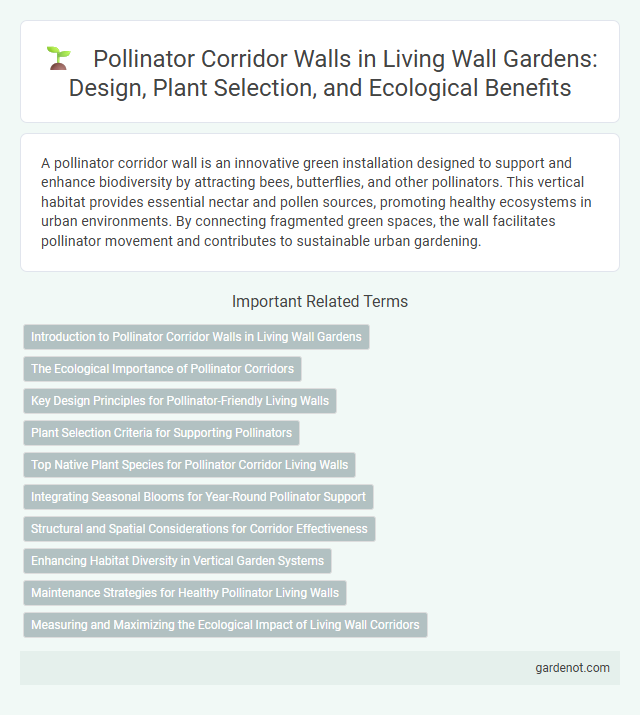A pollinator corridor wall is an innovative green installation designed to support and enhance biodiversity by attracting bees, butterflies, and other pollinators. This vertical habitat provides essential nectar and pollen sources, promoting healthy ecosystems in urban environments. By connecting fragmented green spaces, the wall facilitates pollinator movement and contributes to sustainable urban gardening.
Introduction to Pollinator Corridor Walls in Living Wall Gardens
Pollinator corridor walls in living wall gardens serve as vertical habitats that support bees, butterflies, and other essential pollinators by providing diverse flowering plants and nesting sites. These walls enhance urban biodiversity and contribute to ecosystem health by facilitating the movement and survival of pollinator species in fragmented environments. Incorporating native plant species tailored to local pollinator preferences maximizes ecological benefits and garden resilience.
The Ecological Importance of Pollinator Corridors
Pollinator corridor walls serve as vital ecological connectors, supporting biodiversity by providing essential habitats and food sources for bees, butterflies, and other pollinators in urban environments. These living walls facilitate pollination processes, enhancing plant reproduction and promoting healthier ecosystems. By integrating native flowering plants, pollinator corridors help maintain ecological balance and improve agricultural productivity in surrounding areas.
Key Design Principles for Pollinator-Friendly Living Walls
Pollinator corridor walls feature diverse native flowering plants that bloom sequentially to provide continuous nectar and pollen sources, supporting bees, butterflies, and other pollinators year-round. Structural diversity with varied plant heights and textures enhances habitat complexity and shelter, promoting pollinator foraging and nesting activities. Incorporating non-toxic, pesticide-free materials and ensuring water availability through efficient irrigation systems are essential design principles to maintain healthy pollinator populations in living walls.
Plant Selection Criteria for Supporting Pollinators
Choosing plant species with high nectar and pollen availability is crucial for creating an effective pollinator corridor wall. Native flowering plants that bloom sequentially through the growing season ensure continuous food sources for diverse pollinator species. Incorporating a variety of shapes, colors, and plant heights supports different pollinators, including bees, butterflies, and hummingbirds, optimizing habitat quality and ecological connectivity.
Top Native Plant Species for Pollinator Corridor Living Walls
Top native plant species for pollinator corridor living walls include Asclepias tuberosa (butterfly weed), Echinacea purpurea (purple coneflower), and Monarda fistulosa (wild bergamot). These plants provide essential nectar and pollen resources that attract and support diverse pollinator species such as bees, butterflies, and hummingbirds. Incorporating native species enhances habitat connectivity and promotes biodiversity within urban environments.
Integrating Seasonal Blooms for Year-Round Pollinator Support
A pollinator corridor wall integrates seasonal blooms such as milkweed, coneflowers, and asters, providing continuous nectar and pollen sources essential for bees, butterflies, and hummingbirds throughout the year. Native plant species are strategically selected to bloom sequentially, supporting diverse pollinator populations during critical life stages and migration periods. This approach enhances urban biodiversity and strengthens ecological resilience by maintaining consistent food supplies and habitat connectivity.
Structural and Spatial Considerations for Corridor Effectiveness
The Pollinator Corridor Wall requires careful structural design to support diverse native plant species that attract and sustain pollinators, ensuring optimal root space and water drainage. Spatially, the wall must be strategically positioned to connect fragmented habitats, facilitating pollinator movement and genetic exchange across urban landscapes. Effective integration involves maximizing vertical and horizontal layering to create continuous floral resources, enhancing corridor functionality and biodiversity resilience.
Enhancing Habitat Diversity in Vertical Garden Systems
Pollinator corridor walls significantly enhance habitat diversity by integrating a variety of native flowering plants that provide essential nectar and pollen sources for bees, butterflies, and other pollinators. These vertical garden systems support biodiversity in urban environments by creating continuous green pathways that facilitate pollinator movement and genetic exchange. Incorporating multifunctional plant species within these walls promotes ecosystem resilience and contributes to the sustainability of urban habitats.
Maintenance Strategies for Healthy Pollinator Living Walls
Effective maintenance strategies for pollinator corridor walls include regular monitoring of plant health, pest control using organic methods, and seasonal pruning to promote growth and flowering. Implementing irrigation systems that maintain optimal moisture levels supports pollinator-friendly plants while reducing water waste. Ensuring diverse plant species selection and timely replacement of declining plants fosters a resilient habitat for bees, butterflies, and other pollinators.
Measuring and Maximizing the Ecological Impact of Living Wall Corridors
Measuring the ecological impact of pollinator corridor living walls involves monitoring pollinator visitation rates, species diversity, and plant-pollinator interactions using standardized biodiversity assessment tools. Maximizing impact requires selecting native flowering plant species that provide continuous bloom periods to support diverse pollinator populations, optimizing wall orientation for sunlight exposure, and integrating habitat features such as nesting substrates. Advanced metrics like pollination efficiency and genetic flow assessments help quantify the contribution of living wall corridors to urban ecosystem connectivity and resilience.
Pollinator corridor wall Infographic

 gardenot.com
gardenot.com